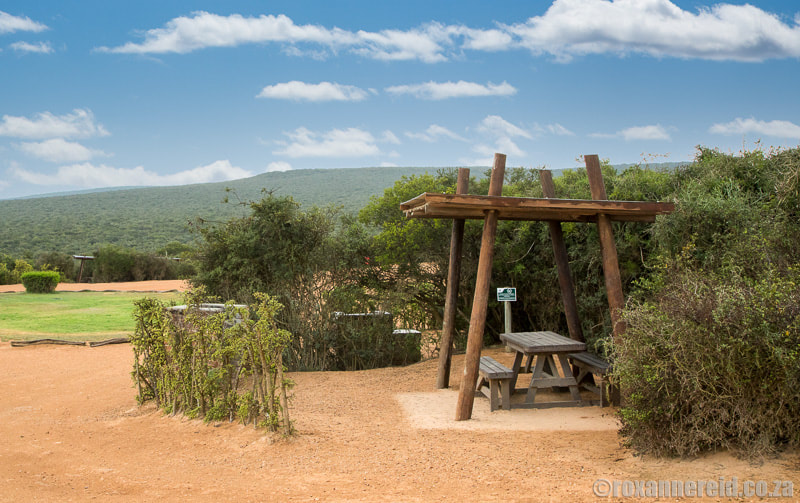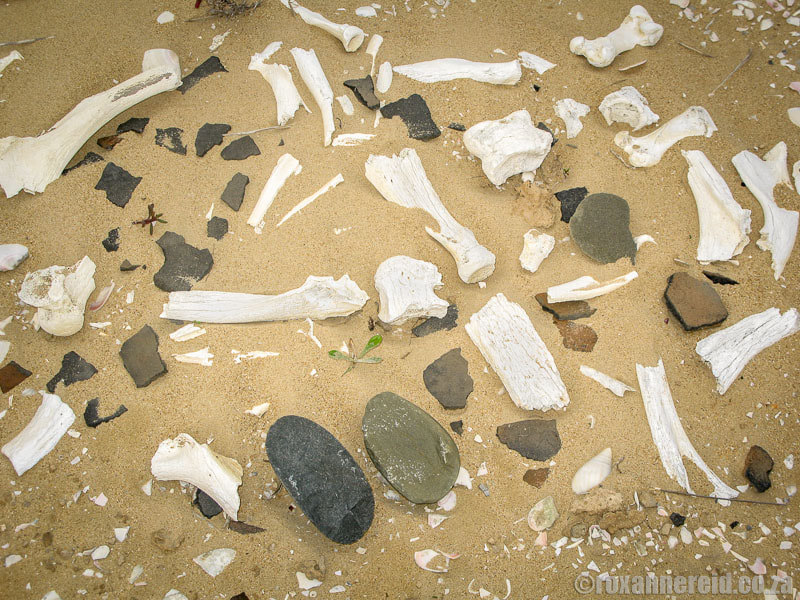By Roxanne Reid
Addo Elephant National Park, about 70km from Gqeberha (Port Elizabeth) in South Africa’s Eastern Cape, is a feast of wildlife, including the Big Seven: elephant, lion, buffalo, leopard and rhino in the main game area, plus sharks and whales in the Marine Protected Area. And don’t forget history and hiking. There’s so much to do in this amazingly diverse park that it’s hard to choose. Here’s my pick of the best 10 things to do at Addo.
Although there were only 11 elephants when Addo Elephant National Park began way back in 1931, there are now more than 600 so seeing them is almost a given, unless the weather is cold and overcast in the early morning when they’ll hide away in the bushes. And don’t forget the little hero here – the flightless dung beetle, rolling like a boss. Did you know they not only eat dung but also breed in it? With all those elephants we can be grateful for these little waste collectors.
Today, Addo is the third biggest national park in the country, stretching from the Zuurberg mountains in the north-west to the Algoa Bay islands and Woody Cape section in the south-east, including the southern hemisphere’s largest coastal dunefield and more Cape gannets than you can shake a selfie stick at.
Best things to do in the main game area
1. Self-drive around the park
Just dying to do a safari at Addo? If, like me, this is your favourite thing, grab the map you get when you check in and take your time cruising the loops. If you’re up for a full-day adventure from Addo Main Camp, slowly make your way south via Rooidam, Hapoor Dam and Marion Baree towards the Ngulube and Vukani loops (good places to look for lions) before returning to camp. You have a fairly good chance of spotting elephant, buffalo, and lion in Addo but keep your eyes peeled for other cool critters like hyenas, bat-eared foxes, aardwolves and meerkats. Look out too for Burchell’s zebra, gemsbok, hartebeest, kudu, and Africa’s largest antelope, the eland. Stop for a packed lunch or braai at Jack’s Picnic Site (see point 5).
2. Join a guided sunrise or night drive
Would you rather put yourself in the hands of an expert? Sign up for a sunrise or night drive with a knowledgeable guide. Chances are you’ll spot animals that only come out at dusk or after dark – bats, owls, spotted and brown hyenas, bat-eared fox, genet, even aardwolf and aardvark. And if you’re really lucky, you might catch a glimpse of a black rhino. Plus, it’s a perfect chance to gaze at the stars and moon without all the camp lights messing up your view. Book in advance at (042) 233-8619, shoot an email to
[email protected], or simply book for the next day at the game drives office when you arrive.
3. Spend time at the waterholes
Hanging out at waterholes is a delight. Picture a whole crew of elephants chilling there. You’ve got the wise old matriarchs doing their graceful trunk thing, slurping up water like it’s an art form. Then you’ve got the teenagers living their best lives, splashing around in the mud and showing off by mock charging doves. And don’t forget the tiny calves that haven’t quite figured out how to use their trunks yet. It’ll take them about a year to learn to control those thousands of muscles properly.
My top spots? Gwarrie Dam, Rooidam, Hapoor Dam, Marion Baree, and Carol’s Rest. We’ve been known to sit at one of these for hours. But if you’re up for something different, visit Domkrag Dam near Addo Main Camp, where you can get out of your car and watch the action from above without freaking out the animals.
Then head further south to waterholes like Peasland and Lismore, where rangers have rigged the waterholes so elephants can’t crash the party. It gives other thirsty animals like zebra, eland and hartebeest, which throng the grasslands nearby, a chance to grab a drink too. That said, I’ve seen video footage of an elephant bull leopard-crawling under the dangling electric wires just to get at the water!
4. Stop at the Spekboom Hide
Don’t miss a stop at the Spekboom Hide; it’s more than just a place to stretch your legs. Stroll down the boardwalk quietly and you might catch sight of some colourful birds on the way. The hide is basically a wooden fence with peepholes so you can spy on the waterhole action. There are some benches for those who prefer to sit and chill. It’s a reliable place to watch elephant, buffalo and warthog, but if you’re patient you might see spotted hyena, kudu, zebra and black-backed jackal too. There’s even a chance of spotting lion if you time it right.
5. Have a picnic at Jack’s Picnic Site
When hunger strikes, head for Jack’s Picnic Site. It’s a picnic paradise in a botanical reserve, behind a gate you need to open and close again behind you. They’ve set up picnic tables in clearings among the bushes of subtropical thicket where you can munch on your sarmies or dunk rusks in your coffee. If you’re feeling energetic and have brought all the fixings with you, fire up a braai in one of the designated spots. There are clean toilets too. On long weekends, the Honorary Rangers sometimes set up at Jack’s to sell boerie rolls to raise funds for their conservation efforts.
Best things to do at Addo Main Camp
6. Visit the Interpretive Centre
Fancy a bit of education mixed in with your adventure? Swing by the Interpretive Centre at Addo Main Camp, where you’ll learn all about Addo’s history, its ecology, and even some wild tales about the park’s famous residents. For instance, Domkrag Dam is named after a ginormous leopard tortoise that used to try to jack up cars (domkrag in Afrikaans means car jack). Tragically, it died when it fell into an aardvark hole and couldn’t escape.
Hapoor, after whom another dam is named, was a legendary elephant recognisable by the nick in his ear, likely caused by a hunter’s bullet. He reigned as Addo’s dominant bull for more than four decades, defeating challengers and occasionally breaching fences to cause havoc on farms nearby. He remains the only elephant ever to have forced his way through the elephant-proof Armstrong fence that still protects the park today.
7. Don’t miss the viewing deck and underground hide
Don’t visit Addo Main Camp without stopping at the viewing deck and underground hide, both prime real estate for catching wildlife action, day or night. Floodlit nights are especially wild with jackals yowling and hyenas giggling– a true African soundtrack. During the day you might spot everything from elephants to warthogs stopping by for a drink.
Pro tip: if you’re into photography, the underground hide nearby is great for getting up close to the animals. As keen photographers, one irritation for us here is that the ground level in front of the hide sometimes cuts off the animals’ feet in photographs and there’s nothing you can do about it.
Best things to do in the Alexandria Dunefield
8. Discover strandloper middens
Ever heard of the Alexandria Dunefield at Addo? It’s a completely different landscape from the main game area and you’ll find it in the Woody Cape section to the south-east. It’s like stepping into a time machine here. Way back when, the place was bustling with strandlopers (beachcombers) or coastal KhoiSan hunter-gatherers who feasted on sand mussels, peppering the dunes with tons of pink and white shells. They also left behind old pots, and tools made from beach pebbles. Some of this stuff goes back a whopping 4 000 years. Much younger middens – a trifling 2 000 years old – contain remnants of the domesticated herds of pastoralists.
And the dunefield itself? Massive. We’re talking dunes as tall as 140m, stretching for miles and miles along the coast and up to 3km wide in some places. The least degraded dunefield in the southern hemisphere, it’s the Namib Desert’s cousin right here in South Africa. The dunes are on the move too. Every year, they sneak about a quarter of a metre further inland, shifting a monumental 350 000 cubic metres of sand. That’s like a tennis-court sized pile of sand stretching nearly four-and-a-half kilometres into the sky.
9. Tackle the Alexandria Hiking Trail
If you’re up for a real adventure, consider booking to do the Alexandria Hiking Trail. It’s a 36km circular trail that’s divided into two days of hiking. It takes you through three very different environments, from ancient forests, to dramatic beaches, and along coastal dunes past those historic shell middens we talked about earlier (see point 8). Imagine hiking among yellowwood trees, spotting Knysna turacos, then overlooking the ocean and catching sight of dolphins or whales.
Stay in the Langebos huts at the start and end of the trail. They have everything from beds and braais to toilets and showers. The Woody Cape hut overlooking the sea and Bird Island will be home at the end of your first day’s hike. It has a water tank for drinking and cooking water only, and there are toilets too. Book ahead to do this trail for a minimum of 3 and maximum of 12 people, tel (041) 468-0916/8, email [email protected]
Best things to do in Algoa Bay & islands
10. Take a marine eco-tour
To get the full Addo experience, you have to go further than the elephants and lions of the main game area to the islands in the Marine Protected Area (MPA) of Addo’s coastal section. Think a full-day trip to Bird Island with the world’s largest Cape gannet colony, or a half-day tour to St Croix Island, which is home to penguins. If you’re a keen birder looking for roseate terns, you’ll want to know that these two islands are among the few places in South Africa where they breed.
To book for one of these tours from Gqeberha (Port Elizabeth), talk to the guys at Raggy Charters. You might catch Cape fur seals, bottlenose and common dolphins, humpback whales, and even southern right whales between June and November. Heck, you might even spot a great white shark if you’re really lucky.
So, next time you’re in Addo, don’t get stuck in the safari rut. Dive into the history of the dunefields, hike a coastal trail, and explore the incredible marine life too.
You may also enjoy
Addo Elephant National Park: everything you need to know
Camdeboo National Park: the ultimate guide
A beginner’s guide to Mountain Zebra National Park
Guide to the Baviaanskloof Wilderness Area, Eastern Cape
Like it? Pin this image!
Copyright © Roxanne Reid – No words or photographs may be used without permission from roxannereid.co.za

































Discussion about this post